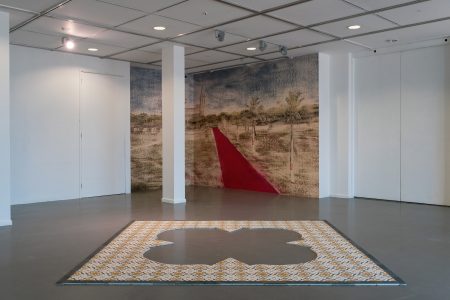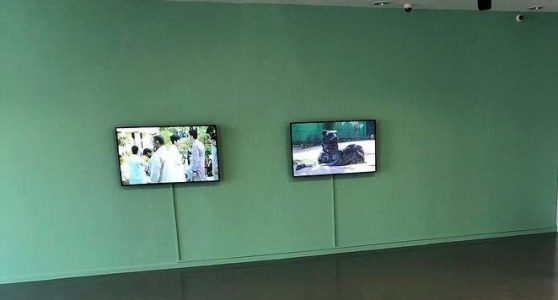Categories
- Amitesh Shrivastava
- Amol K Patil
- Anupam
- Ashwini Bhat
- Baptist Coelho
- Chirodeep Chaudhuri
- Desire Machine Collective
- Goutam Ghosh
- Hemali Bhuta
- Himali Singh Soin
- Huma Mulji
- Khageshwar Rout
- Khageswar Rout
- Mahesh Baliga
- Munem Wasif
- Neha Choksi
- Pallavi Paul
- Prajakta Potnis
- Prasad Shetty & Rupali Gupte
- Raqs Media Collective
- Risham Syed
- Rohini Devasher
- Sandeep Mukherjee
- Sarnath Banerjee
- Shreyas Karle
- Shumon
- Tejal Shah
- The Otolith Group
- Uncategorized
LSE: Huma Mulji: Mobility, Art and Belonging
What is the experience of mobility and migration in an artist’s work? In this post, Simone Wille explores the artworks of the contemporary Pakistani artist Huma Mulji, recently on show in Plymouth (UK), and how memory and belonging inform the multiple journeys — emotional, physical, intellectual and artistic — of creativity, and how they may (in)advertently resonate with wider experiences of belonging.
An academic blog commemorating Pakistan’s 75 years of independence has prompted me to reflect on how I might possibly, rightly and meaningfully participate in it. A reflection on artist Huma Mulji’s exhibition at ‘Mirror’, Arts University Plymouth (on view from 22 July to 14 September 2022) feels appropriate, and provides an opportunity to explore the artist and her career, whose work I have followed since 2001.
Your Tongue in My Mouth is Mulji’s first solo exhibition in the UK. On view are new works by the artist, which she made especially for this exhibition, partly in Karachi — where she grew up and lived most of her live — and partly in Bristol, where she has a studio, is Senior Lecturer in Fine Art at the University of the West of England Bristol, and now lives with her family. Not least for this reason, the composition of this exhibition is informed by artistic choices about how to make connections between geographies, histories, social environments and lived lives; about what to exhibit from life in a former colony to that in the adopted home, the former Empire; about how to re-establish an art practice that is largely concerned with uncertainties, with the insignificant, the non-linear and the everyday. In this blog, I will reflect on what the artist put on display at Plymouth and how this possibly resonates with the 75 years of Pakistan’s birth and independence.
The exhibition in Plymouth showcases video works, sculptures, installations, photographs, and fragrance. These works are clearly composed to relate to, react to and complement each other. In the centre of the gallery is a floor installation made up of tiles with a geometric pattern (‘The Karachi Star’, Image 1). The inside of this patterned surface is carefully milled out and the hollow space left in the middle reveals a geometric shape, but more than that it gives the feeling that something should actually be standing there.
 Image 1: ‘The Karachi Star’, Cement Mosaic Tiles, 306.5 x 306.5 x 1.6 cms, 2022, with ‘Red Carpet’ (in the background), Abraded Inkjet printed on Hewlett Packard, Standard Smooth Wallpaper, 175 gsm, 326 h x 620 cms, 2022 © Huma Mulji; used with permission. See further details below.
Image 1: ‘The Karachi Star’, Cement Mosaic Tiles, 306.5 x 306.5 x 1.6 cms, 2022, with ‘Red Carpet’ (in the background), Abraded Inkjet printed on Hewlett Packard, Standard Smooth Wallpaper, 175 gsm, 326 h x 620 cms, 2022 © Huma Mulji; used with permission. See further details below.
The main wall, featuring a double channel video (‘Gandhi Garden’, Image 2), is painted in a turquoise green which is the colour that appears as a backdrop on the two screens with scenes shot in Karachi Zoo (formerly known as ‘Gandhi Garden’). At this point one is drawn to a framed work of a large scale photocollage (‘Raat ki Rani’, lit. ‘Queen of the Night’, Image 3) that leans onto a pillar, revealing a strong and sweet fragrance. However, the collaged statue does not seem to be the protagonist of the work; rather, it is the improvised environment, the outdoor space, the daylight, the blue sky, the flowers and plants that determines the experience. From here, the eye slides to a work that spans the corner of two walls, a digital inkjet print on adhesive paper, of an urban park with a townhall and a red carpet that stretches from the gallery floor all the way up towards the rear end of the work (‘Red Carpet’, Image 1, in the background). The carpet seems to be intentionally and visibly applied, but the red colour that rubs off from both sides of it into the terrain of the digitally depicted park again represents a connection between the picture planes.
 Image 2: ‘Gandhi Garden’ (Exhibition View), Double Channel Video, 16.45 mins, 2022 © Huma Mulji; used with permission. See further details below.
Image 2: ‘Gandhi Garden’ (Exhibition View), Double Channel Video, 16.45 mins, 2022 © Huma Mulji; used with permission. See further details below.